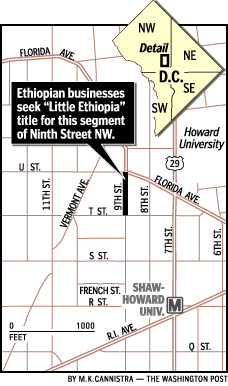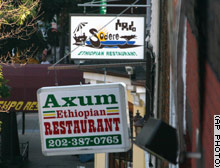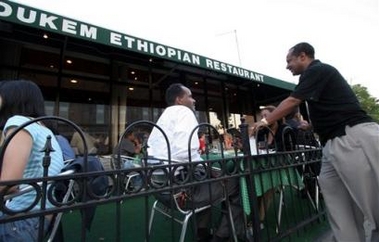One reason why I think the Gentrification word is over- and mis-used
 Washington Post graphic from the article Shaw Shuns 'Little Ethiopia.
Washington Post graphic from the article Shaw Shuns 'Little Ethiopia.You may recall the controversy earlier in the year about designating part of 9th Street NW as "Little Ethiopia" in recognition of the critical mass of restaurants and other Ethiopian-owned businesses there.
Immigration and immigrant entrepreneurialism is the usual source of resurgence in the inner cities. This happens because the properties are cheap and there is little resistance to entry. E.g., certain neighborhoods in Newark are being revitalized through the immigration of those speaking Portuguese. There are Korean neighborhoods in Baltimore. Big cities like Philadelphia have a variety of "recent" ethnic immigration such as Latinos-Hispanics.
DC generally is not a good place for this because even in the worst of times, land and housing prices were relatively high. Still and all, Adams-Morgan in particular became a center for Latino-Hispanic immigration into the Washington area.
But there is also resentment, as was discussed in an article in the Washington Post, "Shaw Shuns 'Little Ethiopia'." From the article:
Derege Zewdie pointed at the gleaming kitchen where cooks will serve up lamb and beef stews, fish and flat bread in the convenience store he plans to open in a few weeks. The rich oak shelves along the wall, he said, will be stocked with coffees, spices and music cassettes from his Ethiopian homeland. Zewdie is among a cluster of Ethiopian entrepreneurs who have brought life to a long-neglected strip in Northwest Washington. They have worked long hours buying and renovating properties, opening restaurants and shops and offices, including one planned as a headquarters for an Ethiopian Chamber of Commerce.
They also are seeking recognition, lobbying the city for a street sign christening the strip "Little Ethiopia," a designation that would "give the rest of the world a chance to know who Ethiopians are," Zewdie said. "It will be on the map."
But the location -- Ninth Street NW between U and T streets in Shaw -- is in a neighborhood steeped in American black history and culture, prompting some community leaders to dismiss the Ethiopians' campaign as inappropriate. "They haven't paid their dues," said Clyde Howard, 71, a retired postal worker and longtime Shaw activist. "Where were they during the [1968] riots? They're Johnny-come-lately. What gives them the right? Just because you opened a store?"
This is why I write that when people use the word gentrification, they really mean change. Change is not merely "white or black." It is multi-faceted. And there is no question that it is difficult.
As Republic of T pointed out in his blog entry referenced below, Dupont Circle used to be the center of gay culture in DC. Now he says it's "hetereosexual."
Having to deal with differences and change is what what most people mean when they use the word "gentrification." At least that's what I think. Or they use it when I think a better phrase would be "neighborhood investment."
This is what I call "Gentrification Effect #2. Here's what I have said about this in the past (from "More about Contested Space--Gentrification"):
But gentrification is phenomenon with multiple effects, which I describe as:
(1) new investment in a previously underinvested area;
(2) change and different people coming into a neighborhood -- most importantly, different people from those currently in residence (the differences--race, class, ethnicity, country of origin, levels of educational attainment, attitudes toward the urban experience, etc.--are usually not "celebrated" (I make this point because I still remember first being taught about diversity and multiculturalism in 7th grade, and I specifically remember the "melting pot" and "celebration of differences" phrase -- I have a hard time seeing the celebration, at least in DC);
(3) increase in conversion of previously rented dwellings to owner-occupied, leading to a displacement of renters and an overall reduction of the number of rental units available in the neighborhood;
(4) related to the new demand for living in the neighborhood is an increase in rental rates, which contributes to the displacement of low- and moderate-income residents;
(5) neighborhood improvement as investment (primarily through the renovation and sale of houses to new residents) continues to increase and begins approaching critical mass (cf. Goetze Building Neighborhood Confidence;
(6) faux-displacement as long-time residents decide to "cash out" and take profits on the sale of the finally appreciated property (this is accelerated by, in my opinion, the still prevalent pro-suburban, anti-city attitudes embraced by particular demographics that tend to represent the long time population groups in traditional center cities); and
(7) ongoing increases in property tax assessments which contributes to the displacement of longtime residents on fixed or lower incomes (note that this effect is hard to separate out from [6]).
The difficulty is that until a few years ago, few urban studies scholars and practitioners really believed that urban neighborhoods could come back and revitalize in a substantive and sustainable fashion. Well, more than anything because of "Friends" and "Seinfeld," and an increasing unwillingness to commute, center cities have experienced a resurgence of interest as places for living, working, and entertainment.
It may well be a resurgence great enough in DC to lead to a critical mass change, even though this isn't the case yet for cities like Baltimore and Philadelphia, while improving, the fact is most of their in-migration is in the center city, with plenty of housing "opportunity" in other areas of the city.
Anyway, I never did write about "Little Ethiopa" before even though I meant to, because of the importance generally, of immigrants to center city revitalization. I bring this up now because this past weekend, the Associated Press ran a travel story over the wire "'Little Ethiopia' takes root in D.C. Capital region has largest Ethiopian community outside Africa." I first saw the article in the Richmond Times-Dispatch travel section, although the link here is to CNN.
Here are the AP photos:
 (This photo is large in the RTD article.)Ethiopian restaurants and stores are part of a new ethnic identity taking root in a Washington neighborhood. AP Photo/Lauren Victoria Burke.
(This photo is large in the RTD article.)Ethiopian restaurants and stores are part of a new ethnic identity taking root in a Washington neighborhood. AP Photo/Lauren Victoria Burke. Tefera Zewdie talks to guests outside his restaurant Dukem. in Washington, Wednesday, Aug. 24, 2005. A new ethnic identity is taking root in a once-decaying neighborhood not far from the White House, where 10 Ethiopian restaurants are clustered together and dingy storefronts are now splashed with bright hues of blues, yellows and reds. (AP Photo/Lauren Victoria Burke)
Tefera Zewdie talks to guests outside his restaurant Dukem. in Washington, Wednesday, Aug. 24, 2005. A new ethnic identity is taking root in a once-decaying neighborhood not far from the White House, where 10 Ethiopian restaurants are clustered together and dingy storefronts are now splashed with bright hues of blues, yellows and reds. (AP Photo/Lauren Victoria Burke) Madjet Ethiopian, left, and Dukem restaurants in Washington, Wednesday, Aug. 24, 2005. (AP Photo/Lauren Victoria Burke)
Madjet Ethiopian, left, and Dukem restaurants in Washington, Wednesday, Aug. 24, 2005. (AP Photo/Lauren Victoria Burke)



0 Comments:
Post a Comment
<< Home